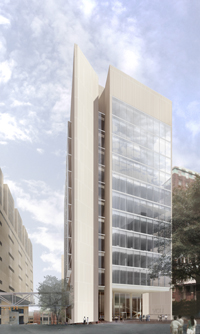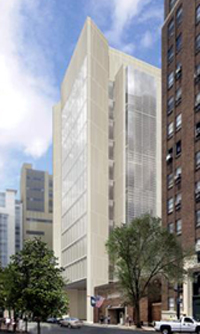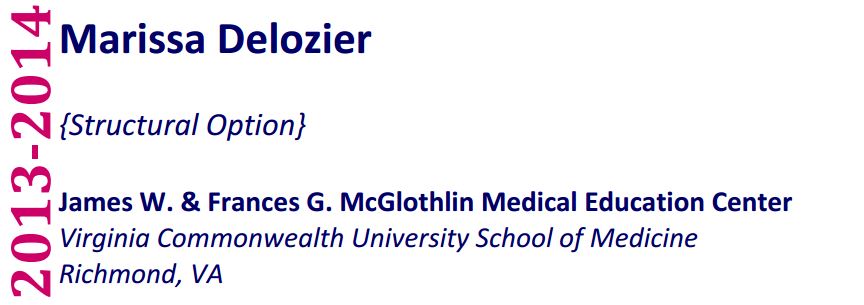[Home] |
[e-Studio] |
| Updates | |
| 4/24/14 | CPEP complete & ready for final review |
| 4/17/14 | Reflection Posted |
| 4/10/14 | Final Presentation Posted |
| 4/08/14 | Thesis Research Posted |
| 4/07/14 | Final Report & Executive Summary Posted |
| 3/31/14 | Presentation Outline Posted |
| 1/16/14 | Thesis Proposal Updated |
| 12/12/13 | Thesis Proposal Posted |
| 11/20/13 | Tech Report 4 & Presentation Posted |
| 10/28/13 | Tech Report 1 Updated |
| 10/23/13 | Building Statistics Part II Posted |
| 10/18/13 | Tech Report 3 & Presentation Posted |
| 10/16/13 | Thesis Abstract Updated |
| 9/27/13 | Tech Report 2 Posted |
| 9/27/13 | Thesis Abstract Posted |
| 9/23/13 | Tech Report 1 Posted |
| 9/11/13 | Student Bio Posted |
| 9/11/13 | Building Statistics Posted |
| 9/10/13 | CPEP Launched |
| 7/10/13 | Owner Permission Received |
Building Statistics
General Building Data
Building Name: James W. & Frances G. McGlothlin Medical Education Center
Location: Richmond, VA
Building Occupant: Virginia Commonwealth University
Type of Building: Multipurpose Education (Administrative, Classrooms, Laboratories)
Size: 220,000 sf
# of Stories: 13 above ground, 1 below ground
Dates of Construction: October 2009 to March 2013 (approximate)
Cost: $159 million
Project Delivery Method: Design-Assist-Build
Primary Project Team
Owner: Virginia Commonwealth University
CM: Gilbane Building Company
Architect + Engineers (Structural, Mechanical, & Electrical): Ballinger
Exterior Architect: Pei Cobb Freed & Partners
Civil Engineer: Draper Aden Associates
Geotechnical Engineer: Geotech, Inc.
Architecture
The new VCU School of Medicine Education Center was designed to not only change the face of the department but to influence the world of medicine, offering an innovative learning environment to cultivate the future leaders of the medical profession. The building offers various collaborative spaces, clinical simulation areas, laboratories, and classrooms to assist with the transformed curriculum of the school. The center also houses a 300-seat lecture hall, allowing for an increase of the student class from 200 to 250. The exterior of the building, designed by internationally acclaimed design firm Pei Cobb Freed & Partners, fits comfortably among the diverse architecture of downtown Richmond, Virginia and the surrounding Virginia Commonwealth University campus.
This project was constructed following the demolition of the A.D. Williams Building, which previously housed the VCU School of Medicine faculty offices, outpatient clinics, and laboratories. The parcel of land used is owned by the Virginia Commonwealth University, so no zoning issues existed. No historical requirements for the project were requested by VCU nor the city of Richmond, Virginia. Major national codes referenced during construction of this building include the 2009 International Building Code and the Virginia Uniform Statewide Building Codes.
Building Enclosure

Building Facade
The building site is located at the corner of East Marshall Street and North 12th Street, making the building facade a focal point from multiple directions. The majority of the exterior is composed of pre-cast concrete panels and glass. The glass serves a dual functionality – not only does it provide sweeping views, but the double layered system also contributes to the cooling and heating of thebuilding. In the images found to the right, the pictured west facing facade demonstrates the dramatic exterior views experienced when approaching the education center.
Roofing
The roofing system consists of a steel deck covered with insulation and followed by a rubber roofing membrane (EPDM). Specific to this project, the Ethylene-Propylene-Diene-Monomer (EPDM) rubber roofing installed was required to have a solar reflectance to meet necessary LEED standards.
Sustainability Features
The James W. & Frances G. McGlothlin Education Center was designed to achieve LEED Silver status; it is expected that the final rating will be released in the near future. As part of a campus-wide initiative to create a “greener” university, several design concepts were integrated in to the building. A major “green” design feature can be found in the exterior walls located on the south and west facades – climate wall systems that trap and exhaust heated air. Energy recovery wheels recover the exhausted heated air and use the contained energy to assist with heating and cooling the building. Storm water is also recovered, from the roof and stored in tanks, to be reused throughout the education center as conditioned water for toilets/urinals and as make-up water for the cooling towers. The roof not only assists with collecting stormwater, but further helps reduce the cooling load required for the building by utilizing reflective roofing materials.
Structural
Foundation
The Sub-Basement and portions of the Basement Levels are slab-on-grade systems, both 10” in total thickness. The foundation system is a combination of three differently sized drilled piers and a caisson-grade beam scheme. The drilled piers account for three variations of loadings: “small” loads (≤ 450 kips), “medium” loads (730 to 1640 kips), and “heavy” loads (> 1640 kips). The caisson-grade beam scheme was used in areas where column lines conflicted with pre-existing pile caps from the demolished building that use to occupy the site.
Framing
The framing system found in the VCU School of Medicine is composite steel construction. The slab-on-deck is composite steel decking topped with concrete. The beams and girders are wide flange steel members that work in conjunction with the slab-on-deck via welded studs. The beams are typically W18x35 members with 16 studs along their length. The girders range in depth and weight, based on the size of the bay.
Lateral System
The lateral load resisting system is steel concentrically braced frames, seven in total throughout the building. Each frame extends the entirety of the structure, with six traveling in one direction and one frame placed in the perpendicular direction. These frames are composed of wide flange steel members, roughly 12” to 14” in depth.
Bridge
A unique structural element of the building is a pedestrian bridge that connects the structure to the existing Main Hospital across E. Marshall Street (a main intersection). The bridge is approximately 65' in length and the same height, 14'-6”, as a typical level in the building. The bridge is slab-on-deck construction with Hollow Structural Section (HSS) Steel members.
Mechanical
There are six Air Handling Units that serve the building, located on the 2nd Floor, 3rd Floor, and in the mechanical penthouse. Three of the six AHUs are located in the mechanical penthouse, have a 27,000 CFM capacity, and serve the chilled beam system in the building. Two of the six AHUs are located on the 2nd Floor; both are 4,200 CFM units that serve the Student Forum and Entrance Lobby. The final AHU can be found on the 3rd Floor – this unit is the sole provider to the 300-seat Auditorium and has a 5,200 CFM capacity.
Heating/cooling for the building is supplied from a heat exchanger/pump system and chillers. Three 450 ton chillers are located in the mechanical penthouse; these chillers are aided by two cooling towers (990 GPM and 655 GPM) on the roof of the structure.
Electrical/Lighting
Electrical power is provided to the building via a 25 kVA transformer positioned on the south-west side of the site. 480/277 volts of power is then delivered to each floor of the building, where it is further reduced to 208/120 for specific uses. If necessary, emergency power is provided by a 500 kW diesel generator.
While there are countless lighting fixtures throughout the building, almost all are fluorescent lamps with dimming ballasts the require an input voltage of 277V. To ensure conservation of energy, dimming sensors were installed through the majority of the building.
Construction
The new VCU School of Medicine was constructed following the demolition of the former home to the school, the A.D. Williams Building, which previously inhabited the site. The new construction was $159 million dollars and was a Design-Assist-Build contract held between Virginia Commonwealth University, Ballinger, and Gilbane Building Company. The new construction started in October 2009 and was awarded substantial completion in March 2013.
Fire Protection
All steel structural frame elements (columns, girders, and trusses) in the building meet a 3 hour fire resistance rating. Floor construction is rated for 2 hours, while the roof construction is rated at 1 ½ hours. Bearing walls, both exterior and interior, are also rated at 2 hours of fire resistance. This is especially important for walls surrounding the transportation systems. Some, but not all, of the exterior non-bearing walls meet fire resistance ratings (based on fire separation distance to adjacent structures). An active fire protection system composed of sprinklers and standpipes covers the entire building, including the pedestrian bridge and connection to the Main Hospital.
Transportation
There are five gearless traction passenger elevators located in the new VCU School of Medicine building. Four of the five elevators are located in one centralized location, or bay, and have a 4,000 lbs capacity. The final elevator has a 6,000 lbs carrying capacity and is intended for janitorial/building staff use. The four elevators designated for public use travel from the Basement Level to the 12th Floor, while the service elevator continues travel to the 13th Floor.
Excluding the main staircase that connects the Basement Level to the Main Floor Lobby, there are three stairwells the continue throughout the entirety of the structure. One stairwell is adjacent to the elevator bay, while the other two are situated at the opposite corners of the structure, providing accessible means of egress. Two of the three stairwells are surrounded by fire-rated enclosures and provide the required 42” of necessary width for life safety concerns.
[The Pennsylvania State University] [Architectural Engineering] [AE Computer Lab] [Senior Thesis] [Contact Info]
This page was last updated on April 24, 2014, by Marissa Delozier and is hosted by the AE Department © 2014.
